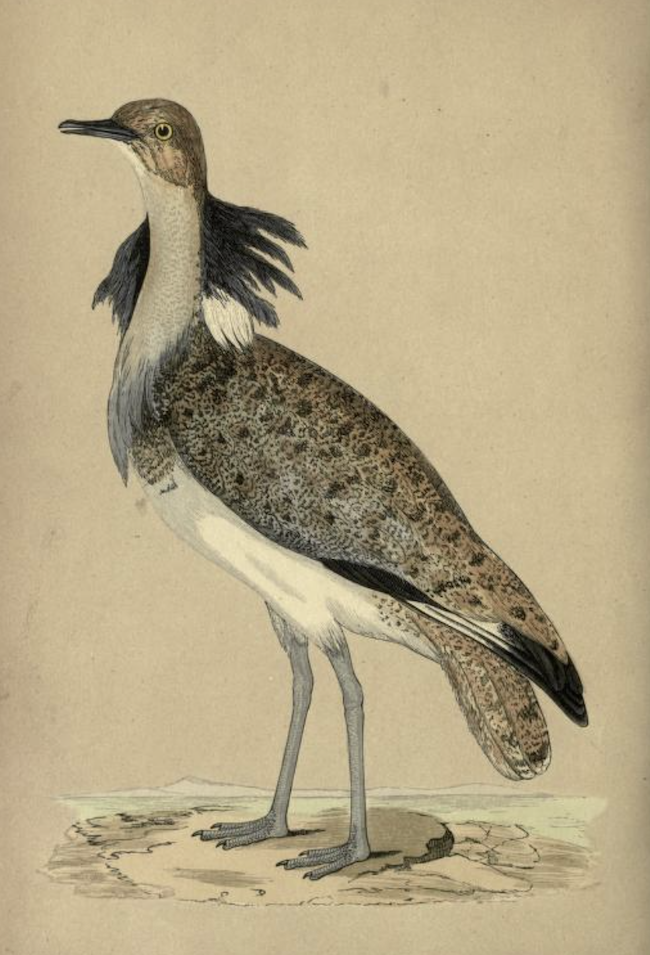Asian Houbara Bustard Chlamydotis macqueenii
Vagrant. Central Asia.

Asian Houbara (Macqueen's or Ruffed) Bustard. Illustration by Morris (1852) from the BHL archive.
The single occurrence of this species, identified at the time as a Houbara Bustard Chlamydotis undulata and assigned to the eastern race C. undulata macqueeni by J. Gould, was much later elevated to full specific status as Macqueen’s Bustard C. macqueenii. All five British records of Houbara Bustard C. undulata were accepted as being C. macqueenii and so Houbara Bustard was removed from the British and Lincolnshire Lists. The county thus ‘lost’ Houbara Bustard due to this taxonomic update and ‘gained’ Macqueen’s Bustard. A colour plate and a description of the bird were published by Morris (1852) as follows:
We have been induced to give a coloured plate of this very interesting addition to the list of British birds, from there being, as far as we are aware, no figure of it except in Gould's expensive work, which is not accessible to many of our readers. The plate is taken from an admirable drawing made from the bird itself by Miss Barker, a young lady who kindly painted the bird for Mr. Graham, of York, to whom we are indebted for the loan of the picture.
The bird was shot at Kirton Lindsey, in Lincolnshire, on the 7th of October, 1847, by Mr. G. Hansley, who parted with it to Mr. Alfred Roberts, of Brigg, from whom it was purchased by E. T. Higgins, Esq., of York. The bird is now in the Rudston collection of British Birds, in the Museum of the Yorkshire Philosophical Society.
Description: - The bill is dark lead-colour, compressed at the tip, depressed at the base; irides, yellow; the head and throat, rufous, mottled with black, with long loose feathers of a slate colour, hanging over the breast. Chin, white; back of the neck, white, minutely mottled with brown; the sides of the neck are ornamented with a range of feathers two inches long, about two-thirds of the upper portion black, the lower part white. The back and wing coverts, rufous, mottled with black, with zigzag bars of black across; the quill feathers black, extending to the end of the tail when closed; under parts, white; legs, lead-colour. Length, twenty-three inches; expanse of wings, three feet eight inches; weight thirty-six ounces.
Although this is the only specimen of this Bustard that is known to have occurred in this country, yet its having evidently come as a voluntary visitor to our shores, gives it a decided claim to a place in the British list. The coloured figure which we now give, will enable any one readily to recognise the bird, should it ever come under his notice. Let us hope that if such an occurrence should take place, The Naturalist may be the medium of making the interesting fact known to the scientific world.
The Central Asian populations are strongly migratory, leaving their breeding grounds in August–October on trans-Himalayan migration and are thus prone to vagrancy. They have occurred in many European countries west to France and Britain as well as to the Middle East (Lebanon). However, the species has suffered severe declines from overhunting, with an estimated 4360 birds killed by local and visiting hunters in winter 1982/83, and 4955 in 1984/85 in Pakistan for example. In addition to hunting, other threats include intensive agricultural practices, human disturbance and habitat degradation through livestock overgrazing. A repeat record would seem to be unlikely.
| Site | First date | Last date | Count | Notes |
| Kirton in Lindsey | 07/10/1847 | 1 | Shot in a stubble field at Kirton Lindsey, the first British record |
Reference
Cordeaux, J. (1872) Birds of the Humber District. John Van Voorst, London.
Morris, B. R. 1852. The Ruffed, or McQueen's Bustard. Naturalist (Morris's and Bree's) 2: 89.
Naturalist (Morris). n.d. Vol. 1. London. https://www.biodiversitylibrary.org/page/2497037.
Naylor, KA 2025 Historical Rare Birds <https://www.historicalrarebirds.info/>
(Account as per new Birds of Lincolnshire (2021), included September 2022)

